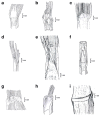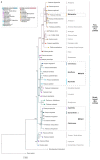Phylogenomics and Systematics of Overlooked Mesoamerican and South American Polyploid Broad-Leaved Festuca Grasses Differentiate F. sects. Glabricarpae and Ruprechtia and F. subgen. Asperifolia, Erosiflorae, Mallopetalon and Coironhuecu (subgen. nov.)
- PMID: 36079685
- PMCID: PMC9460391
- DOI: 10.3390/plants11172303
Phylogenomics and Systematics of Overlooked Mesoamerican and South American Polyploid Broad-Leaved Festuca Grasses Differentiate F. sects. Glabricarpae and Ruprechtia and F. subgen. Asperifolia, Erosiflorae, Mallopetalon and Coironhuecu (subgen. nov.)
Abstract
Allopolyploidy is considered a driver of diversity in subtribe Loliinae. We investigate the evolution and systematics of the poorly studied Mesoamerican and South American polyploid broad-leaved Festuca L. species of uncertain origin and unclear taxonomy. A taxonomic study of seven diagnostic morphological traits was conducted on a representation of 22 species. Phylogenomic analyses were performed on a representation of these supraspecific taxa and all other Loliinae lineages using separate data from the entire plastome, nuclear rDNA 45S and 5S genes, and repetitive DNA elements. F. subgen. Mallopetalon falls within the fine-leaved (FL) Loliinae clade, whereas the remaining taxa are nested within the broad-leaved (BL) Loliinae clade forming two separate Mexico-Central-South American (MCSAI, MCSAII) lineages. MCSAI includes representatives of F. sect. Glabricarpae and F. subgen. Asperifolia plus F. superba, and MCSAII of F. subgen. Erosiflorae and F. sect. Ruprechtia plus F. argentina. MCSAII likely had a BL Leucopoa paternal ancestor, MCSAI and MCSAII a BL Meso-South American maternal ancestor, and Mallopetalon FL, American I-II ancestors. Plastome vs. nuclear topological discordances corroborated the hybrid allopolyploid origins of these taxa, some of which probably originated from Northern Hemisphere ancestors. The observed data indicate rapid reticulate radiations in the Central-South American subcontinent. Our systematic study supports the reclassification of some studied taxa in different supraspecific Festuca ranks.
Keywords: Mexico–Central–South American broad-leaved Festuca; allopolyploid speciation; phylogeny; plastome; rDNA 45S and 5S genes; repeatome; taxonomy.
Conflict of interest statement
The authors declare no conflict of interest.
Figures







Similar articles
-
Evolutionary Dynamics of the Repeatome Explains Contrasting Differences in Genome Sizes and Hybrid and Polyploid Origins of Grass Loliinae Lineages.Front Plant Sci. 2022 Jul 1;13:901733. doi: 10.3389/fpls.2022.901733. eCollection 2022. Front Plant Sci. 2022. PMID: 35845705 Free PMC article.
-
Polyphyly, gene-duplication and extensive allopolyploidy framed the evolution of the ephemeral Vulpia grasses and other fine-leaved Loliinae (Poaceae).Mol Phylogenet Evol. 2014 Oct;79:92-105. doi: 10.1016/j.ympev.2014.06.009. Epub 2014 Jun 18. Mol Phylogenet Evol. 2014. PMID: 24952319
-
Dated historical biogeography of the temperate Loliinae (Poaceae, Pooideae) grasses in the northern and southern hemispheres.Mol Phylogenet Evol. 2008 Mar;46(3):932-57. doi: 10.1016/j.ympev.2007.11.022. Epub 2007 Dec 5. Mol Phylogenet Evol. 2008. PMID: 18226932
-
Phylogeny of the festucoid grasses of subtribe Loliinae and allies (Poeae, Pooideae) inferred from ITS and trnL-F sequences.Mol Phylogenet Evol. 2004 May;31(2):517-41. doi: 10.1016/j.ympev.2003.08.025. Mol Phylogenet Evol. 2004. PMID: 15062792
-
Museomics Unveil the Phylogeny and Biogeography of the Neglected Juan Fernandez Archipelago Megalachne and Podophorus Endemic Grasses and Their Connection With Relict Pampean-Ventanian Fescues.Front Plant Sci. 2020 Jun 26;11:819. doi: 10.3389/fpls.2020.00819. eCollection 2020. Front Plant Sci. 2020. PMID: 32754167 Free PMC article.
Cited by
-
Preliminary checklist of the genus Festuca L. (Loliinae, Pooideae, Poaceae) in the Altai Mountains with outlines for further studies.PhytoKeys. 2023 Oct 26;234:229-274. doi: 10.3897/phytokeys.234.105385. eCollection 2023. PhytoKeys. 2023. PMID: 37927970 Free PMC article.
References
LinkOut - more resources
Full Text Sources

